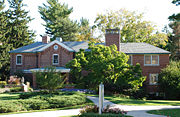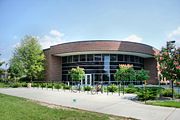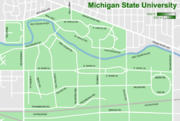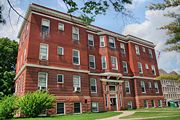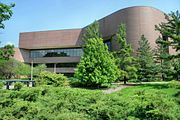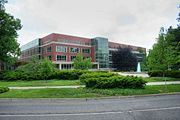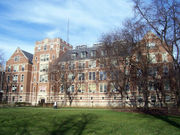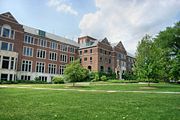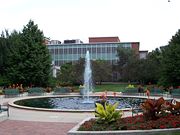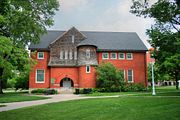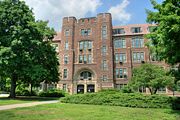Michigan State University
2008/9 Schools Wikipedia Selection. Related subjects: North American Geography
| Michigan State University | |
|---|---|
 |
|
|
|
|
| Motto: | Advancing Knowledge. Transforming Lives |
| Established: | February 12, 1855 |
| Type: | Public, Land Grant, University, Sea Grant, Flagship |
| Endowment: | US $1.631 billion |
| President: | Dr. Lou Anna Simon |
| Faculty: | 4,800 |
| Staff: | 6,100 |
| Students: | 46,045 |
| Undergraduates: | 36,072 |
| Postgraduates: | 9,973 |
| Location: | East Lansing, Michigan, USA |
| Campus: | Suburban (21 km²) campus 2,000 acres (8 km²) in existing or planned development |
| Sports: | Spartans |
| Colors: | Green and White |
| Mascot: | Sparty |
| Website: | msu.edu |
 |
|
Michigan State University (MSU) is a co-educational public research university in East Lansing, Michigan USA. Founded in 1855, it was the pioneer land-grant institution and served as a model for future land-grant colleges in the United States under the 1862 Morrill Act. Its alumni include at least five winners of the Pulitzer Prize and more Rhodes Scholars than any other university in the Big Ten. MSU pioneered the studies of packaging, hospitality business, telecommunication, and music therapy. Today its study-abroad program is the largest of any single-campus university in the country, offering more than 200 programs in more than 60 countries on all continents including Antarctica. It is considered to be one of America's Public Ivy universities, which recognizes top public research universities in the United States.
Following the introduction of the Morrill Act, the college became coeducational and expanded its curriculum beyond agriculture. After World War II, the number of students tripled as the institution became a major university. Today, MSU is the eighth-largest university in the United States, with 46,045 students and 2,954 faculty members.
MSU's Division I sports teams are called the Spartans. They compete in the Big Ten Conference in all sports except ice hockey, in which the team is part of the Central Collegiate Hockey Association. MSU's football team won the Rose Bowl in 1954, 1956, and 1988 and boasts six national championships. Its men's basketball team won the NCAA National Championship in 1979 and 2000. The MSU men's ice hockey has won national titles in 1966, 1986, and 2007.
History
Agriculture school
The Michigan Constitution of 1850 called for the creation of an "agricultural school", though it was not until February 12, 1855 that Michigan Governor Kinsley S. Bingham signed a bill establishing the United States' first agriculture college, the Agricultural College of the State of Michigan. Classes began in May 1857 with three buildings, five faculty members, and 63 male students. The first president, Joseph R. Williams, designed a curriculum that required more scientific study than practically any undergraduate institution of the era. It balanced science, liberal arts, and practical training. The curriculum excluded Latin and Greek studies, since most applicants did not study any classical languages in their rural high schools. However, it did require three hours of daily manual labor, which kept costs down for both the students and the College. Despite Williams' innovations and his defense of education for the masses, the State Board of Education saw Williams' curriculum as elitist. They forced him to resign in 1859 and reduced the curriculum to a two-year vocational program.
Land Grant pioneer
In 1860, Joseph Williams became acting lieutenant governor and helped pass the Reorganization Act of 1861. This gave the College a four-year curriculum and the power to grant master's degrees. Under the act, a newly-created body, known as the State Board of Agriculture, took over from the State Board of Education in running the institution. The College changed its name to State Agricultural College, and its first class graduated in the same year. However, there was no time for an elaborate graduation ceremony: the Civil War had just begun, and the first alumni enlisted to the Union Army. The following year, Abraham Lincoln signed the First Morrill Act of 1862 to support similar colleges, making the Michigan school a national model. Williams never witnessed the cause to which he had dedicated so much of his life, having taken ill and died the previous year.
Co-ed college
The college first admitted women in 1870, although at that time there were no female residence halls. The few women who enrolled either boarded with faculty families or made the arduous stagecoach trek from Lansing. Nonetheless, even from the early days female students took the same rigorous scientific agriculture courses as male students. In 1896, the faculty created a "Women Course" that melded a home economics curriculum with liberal arts and sciences. That same year, the College turned the old Abbot Hall male dorm into a women's dormitory and more firmly established itself as co-ed. However, it was not until 1899 that the State Agricultural College admitted its first African American student, William O. Thompson. He went on to teach at what is now Tuskegee University under the wing of Booker T. Washington, whom President Jonathan L. Snyder invited to be the Class of 1900 commencement speaker. A few years later, Myrtle Craig became the first female African American student to enroll at the College. Along with the Class of 1907, she received her degree from U.S. President Theodore Roosevelt, commencement speaker for the Semi-Centennial celebration. The City of East Lansing was incorporated in that same year, and two years later the college officially changed its name to Michigan Agricultural College (M.A.C.).
Big Ten university
During the early 20th century, M.A.C. expanded its curriculum well beyond agriculture. By 1925, it had expanded enough that it changed its name to Michigan State College of Agriculture and Applied Science (M.S.C.). In 1941, the Secretary of the State Board of Agriculture, John A. Hannah, became president of the College. He began the largest expansion in the institution's history, with the help of the 1945 G.I. Bill, which helped World War II veterans to receive an education. One of Hannah's strategies was to build a new dormitory building, enroll enough students to fill it, and use the income to start construction on a new dormitory. Under his plan, enrollment increased from 15,000 in 1950 to 38,000 in 1965. Hannah also got the chance to improve the athletic reputation of M.S.C. when the University of Chicago resigned from the Big Ten Conference in 1946. Hannah lobbied hard to take its place, gaining admission in 1950. Five years later, in its Centennial year of 1955, the State of Michigan renamed the College as Michigan State University of Agriculture and Applied Science. Nine years after that, the University governing body changed its name from the State Board of Agriculture to the MSU Board of Trustees. [The State of Michigan] allowed the University to drop the words "Agriculture and Applied Science" from its name. Since 1964, the institution has gone by the name of Michigan State University.
Global leader by 2012
Since the end of the Hannah era, Michigan State has shifted its focus from increasing the size of its student body to advancing its national and global reputation. In September 2005, current president Lou Anna Simon called for MSU, one of the public ivy institutions, to become the global model leader for Land Grant institutions by the year 2012. Her plans include creating a new residential college and increasing National Institutes of Health donations past the $100 million mark. While there are over 100 Land-grant universities in the United States, she has stated that she would like Michigan State University to be the leader.
Campus
MSU's sprawling campus is located in East Lansing. The campus is perched on the banks of the Red Cedar River. Development of the campus started in 1856 with three buildings: a multipurpose building called College Hall, a dormitory later called " Saints' Rest", and a barn. Today, MSU's contiguous campus consists of 5,200 acres (21 km²), 2,000 acres (8 km²) of which are developed. There are currently 676 buildings: 203 for academics, 154 for agriculture, 245 for housing and food service, as well as 74 other buildings. Overall, the University has 21,931,085 square feet (2,037,464.5 m²) of total indoor space. Connecting it all is 26 miles (43 km) of roads and 100 miles (161 km) of sidewalks. MSU also owns 44 non-campus properties, totaling 22,000 acres (89 km²) in 28 different counties.
North campus
The oldest part of campus lies on the north bank of the Red Cedar. It includes Collegiate Gothic architecture, plentiful trees, and curving roads with few straight lines. It was in this area that the College built its first three buildings, of which none survive. Other historic buildings north of the river include Cowles House, the president's official residence, and Beaumont Tower, a carillon clock tower marking the site of College Hall, the original classroom building. To the east lies Eustace-Cole Hall, America's first freestanding laboratory for horticulture. Other landmarks include the bronze statue of former president John A. Hannah, the W. J. Beal Botanical Garden, and the painted boulder known as " The Rock", which is a popular spot for theatre, tailgating, and candlelight vigils. On the northwest corner of campus lies the University's hotel, the Kellogg Hotel and Conference Centre.
South campus
The campus south of the river consists mostly of post-World War II International Style buildings with sparse foliage, relatively straight roadways, and numerous parking lots. The "2020 Vision" Master Plan proposes replacing these parking lots with parking ramps and green space, but these plans will take many years to reach fruition. As part of the master plan, the University erected a new bronze statue of " The Spartan" in 2005. This replica replaced the original modernist terra cotta statue, which can still be seen inside Spartan Stadium. Notable academic and research buildings on the South Campus include the Cyclotron and the College of Law. This part of campus is home to the MSU Horticulture Gardens and the adjoining 4-H Children's Garden. South of the gardens lie the Canadian National and CSX railroads, which divide the main campus from thousands of acres of university-owned farmland. The university's agricultural facilities include the Horse, Dairy Cattle, Beef Cattle, Sheep, and Poultry Teaching and Research Farms, as well as the Air Quality Control Lab and the Diagnostics Centre for Population and Animal Health.
Academics
MSU has the eighth largest student body in the U.S. There are 45,520 total students, with 35,821 undergraduates and 9,699 graduate and professional students. The student body is 55% female and 45% male. While 89% of students come from all 83 counties in the State of Michigan, also represented are all 50 states in the U.S. and about 125 other countries. MSU has about 4,500 faculty and 6,000 staff members, and a student/faculty ratio of 19:1. Listed as a Public Ivy, Michigan State is a member of the Association of American Universities. Michigan State University Ombudsman is the longest continually operating ombudsman office at a college or university in the country. Albert Fert, an Adjunct professor at MSU, was awarded the 2007 Nobel Prize in Physics together with Peter Grünberg. Finally, MSU's study abroad program is the largest of any single-campus university in the United States with 2,461 students studying abroad in 2004–2005 in over 60 countries on all continents, including Antarctica.
Its admissions are moderately difficult; for 2006's entering class, the 25th/75th percentiles for the SAT were 1040 and 1270/1600, and its 25th/75th percentiles on the ACT were 22 and 27/36.
Rankings
Michigan State ranks 80th in the world, according to a Shanghai Jiao Tong University study, which measures scientific research leading towards a Nobel Prize. with U.S. News & World Reports ranking MSU 71st in the U.S. The university has over 200 academic programs. U.S. News has ranked MSU's graduate-level elementary education", secondary education, and Industrial and Organizational Psychology programs number one for the last decade. In addition, the 2008 U.S. News ranks Michigan State's Supply Chain Management program in the Eli Broad College of Business number one in the nation for the second year in a row. In primary medical care, U.S. News ranks MSU's College of Osteopathic Medicine at number five, College of Veterinary Medicine at number nine, and the College of Human Medicine at eighteen. Other programs of note include criminal justice, music therapy, hospitality business, packaging, political science, dietetics and communications.
Research
The university spent nearly $377 million in 2006–07 on research, capping a long history of academic research. In 1877, botany professor William J. Beal performed the first documented genetic crosses to produce hybrid corn, which led to increased yields. MSU dairy professor G. Malcolm Trout invented the process for the homogenization of milk in the 1930s. In the 1960s, MSU scientists developed cisplatin, a leading cancer fighting drug. Today Michigan State continues its research with facilities such as the U.S. Department of Energy-sponsored MSU-DOE Plant Research Laboratory and a particle accelerator called the National Superconducting Cyclotron Laboratory.
In 2004, scientists at the Cyclotron produced and observed a new isotope of the element germanium, called Ge-60. In that same year, Michigan State, in consortium with the University of North Carolina at Chapel Hill and the government of Brazil, broke ground on the 4.1-meter Southern Astrophysical Research Telescope (SOAR) in the Andes Mountains of Chile. The consortium telescope will allow the Physics & Astronomy department to study galaxy formation and origins. Since 1999, MSU has been part of another consortium called the Michigan Life Sciences Corridor, which aims to develop biotechnology research in the State of Michigan. Finally, the College of Communication Arts and Sciences' Quello Centre researches current issues of information and communication management.
Endowment
MSU's (private, non-Morrill Act) endowment started in 1916 when the Engineering Building burned down. Automobile magnate R.E. Olds helped the program stay afloat with a gift of $100,000. While this opened the door for other types of private donations, MSU has often lagged behind peer institutions in terms of endowments. As recently as the early 1990s, MSU was last among the eleven Big Ten schools, with barely over $100 million in endowment funds. However, in the early 2000s, the University started a campaign to increase the size of the endowment. At the close of fiscal year 2004–2005, the endowment had risen to $1.325 billion, raising the University to sixth of the 11 Big Ten schools in terms of endowment; within $2 million of the fifth-rated school. The rapid increase in the size of the endowment will help to improve outdated facilities, such as the Music Building, which the College of Music hopes to soon replace with money from its alumni fundraising program.
Colleges
MSU has over 200 academic programs offered by 17 degree granting colleges.
Residential colleges
MSU has several residential colleges, based on the Oxbridge "living-learning" model. By putting classes in student dormitories, these colleges improve student access to faculty and facilities. MSU's first residential college, Justin Morrill College started in 1965 with an interdisciplinary curriculum. MSU closed Morrill College in 1979, but today the university has three residential colleges, including the recent opening of the Residential College in Arts and Humanities located in Snyder and Phillips halls.
Started in 1967, James Madison College tries to merge the best attributes of a small public affairs college and a major university. Classes in the college are small, with an average of 25 students, and most instructors are tenure track faculty. James Madison College has about 1150 students total, with each freshman class containing about 320 students. Each of Madison's four majors—Social Relations and Policy, International Relations, Political Theory and Constitutional Democracy, and Comparative Cultures and Politics—requires two years of foreign language and one semester of "field experience” in an internship or study abroad program. Although Madison students make up about 4% of MSU graduates, they represent around 35% of the MSU’s Phi Beta Kappa members.
Founded in 1961, The Lyman Briggs College teaches math and science within social, historical and philosophical contexts. Many Lyman Briggs students intend to pursue careers in medicine, but the school supports over 30 coordinate majors, from human biology to computer sciences. Lyman Briggs is one of the few colleges that lets undergraduates teach as "Learning Assistants."
MSU's newest residential college is the Residential College in Arts & Humanities. Founded October 21, 2005, the college provides around 600 undergraduates with an individualized curriculum in the liberal, visual and performing arts. Though all the students will graduate with the same degree, MSU encourages students in the college to get a second degree or specialization. The university houses the new college in a newly-renovated Snyder-Phillips Hall, the location of MSU's first residential college, Justin Morrill College.
Professional schools
The Michigan State University College of Law is a private law school, even though MSU is a public institution. Founded in Detroit in 1891 as the Detroit College of Law, MSU bought the school in 1995, and moved it to East Lansing. Students attending MSU College of Law come from 42 states and 13 countries. The law school publishes the Michigan State Law Review and the Journal of Business and Securities Law, a student-run law journal dedicated to business and securities law. Michigan State University College of Law is the home of the Geoffrey Fieger Trial Practice Institute, the first trial practice institute in the United States. The Intellectual Property and Communications Law program is ranked seventeenth nationally.
The Eli Broad College of Business has programs in accounting, information systems, finance, management, marketing and supply chain management, and hospitality business. The school has 4,775 undergraduate students and 776 graduate students. The Eli Broad Graduate School of Management, which Business Week magazine ranks 11th among public institutions, offers three MBA programs, as well as joint degrees with the College of Law. The opening of the Eugene C. Eppley Centre for Graduate Studies in Hotel, Restaurant and Institutional Management brought the first program in the United States to offer a Master of Business Administration degree in Hotel, Restaurant and Institutional Management to MSU.
Medical schools
The MSU College of Osteopathic Medicine was the world's first publicly-funded college of osteopathic medicine. It has a long-standing tradition of retaining its alumni in Michigan to practice – more than two-thirds of the college’s graduates remain to practice in Michigan. Recently, the Michigan State University Board of Trustees approved a resolution endorsing the expansion of the College of Osteopathic Medicine to two sites in southeast Michigan, a move board members and college officials say will not only improve medical education in the state, but also address a projected physician shortage. The college has regularly ranked among the top ten medical schools in the country (DO and MD) for primary care according to U.S. News & World Report.
The College of Human Medicine graduates students with medical doctor MD degrees and is split into six distinct campuses located in Lansing, Kalamazoo, Flint, Saginaw, Marquette and Grand Rapids. Each campus is affiliated with local hospitals and other medical facilities professionals in the area. For example, the Lansing campus includes Sparrow Health System and Ingham Regional Medical Centre. The College of Human Medicine has recently gained attention for its expansion into the Grand Rapids area, where a new campus is being built that is expected to fuel the growing medical industry in that region.
Though Michigan State has offered courses in veterinary science since its founding, the College of Veterinary Medicine was not formally established as a four-year, degree-granting program until 1910. Ranked ninth in the nation, the college has over 170,000 square feet (16,000 m²) of office, teaching, and research space, as well as a veterinary teaching hospital.
Other academic units
In recent years, MSU's music program has grown substantially. Music major enrollment increased more than 97% between 1991 and 2004. In early 2007, this growth led the university board of trustees to spin the music program off into its own college unit: The MSU College of Music. The new college faces many new challenges, such as working with limited space and funding. Nevertheless, MSU's music college plans on continued success, placing an annual average of 25 graduate students in tenure stream university positions.
MSU's College of Education at Michigan State University offers graduate and undergraduate degrees in several fields, including counseling, educational psychology, special education, teacher education and kinesiology. The college has had top-ranked programs in elementary , educational technology, and secondary education for 14 years in a row. In addition, Michigan State ties the University of Wisconsin–Madison for the top spot in rehabilitation counseling.
Founded in 1956, the MSU Honours College provides individualized curricula to MSU's top undergraduate students. Though the college has no majors of its own, it has its own dean and academic advisers to help honours students with their educational pursuits. High school students starting at MSU may join the Honours College if they are in the top 5% of their high school graduating class and have either an ACT score of at least 30 or an SAT total score of at least 1360. Students who do not enter Michigan State as Honours College members may apply for membership if they achieve a grade point average of at least 3.50 at MSU. Once admitted, students must maintain a 3.20 GPA and complete eight honors in order to graduate with an Honours College degree.
MSU currently offers a 30 credit graduate program for Masters in Educational Technology located in Plymouth, England. The program lasts one month a summer for three summers, with each summer covering 9 credit hours. One online class is required between the second and third summer. The classes are focused on preparing teachers in integrating technology into their classrooms and helping them understand the affordances and constraints of using different programs. The courses are taught by MSU professors and are open to students around the world.
Athletics
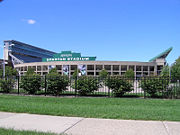
Michigan State's NCAA Division I-A program offers 12 varsity sports for men and 13 for women. Since their teams are called the Spartans, MSU's mascot is a Spartan warrior named Sparty. The university participates in the Big Ten Conference in all varsity sports except ice hockey, which competes in the Central Collegiate Hockey Association. The current athletic director is Mark Hollis, who was promoted to the position on January 1, 2008. Hollis replaced Ron Mason, who served as head hockey coach from 1979 to 2002, retiring with a record total of 924 wins, and a 635–270–69 record at MSU. MSU's Spartan Marching Band plays the fight song at every university event, and both students and alumni sing along.
Michigan State is among only sixteen Division 1A programs to win multiple national titles in football, and the only school to win multiple national titles in football, basketball, and hockey (also, along with the University of Florida, MSU is one of only two schools to win multiple national titles in both football and basketball). MSU has won all of its football championships playing only division 1A opponents and has never played a division 1AA program. The Spartans have participated in two events, in basketball and ice hockey, which have set world records for spectator attendances for both sports.
Football
Football has a long tradition at Michigan State. Starting as a club sport in 1884, football gained varsity status in 1896. It won the Rose Bowl in 1954, 1956, and 1988. In 1967 the Spartans accounted for four of the top eight picks in the NFL draft, the only time a college football program has accomplished such feat.
Today, the football team competes in Spartan Stadium, a renovated 75,005 person football stadium near the centre of campus. The current coach is Mark Dantonio, who was hired on November 27, 2006. Dantonio had an 18–17 record in his three year tenure at the University of Cincinnati, including a 1–0 Bowl Game record. He led the team in its first season to a 7–6 record. The Spartans played in the Champs Sports Bowl against Boston College on December 28th. MSU's traditional archrival is the University of Michigan, against whom they compete annually for the Paul Bunyan Trophy. Michigan State is one of three Big Ten teams to have an annual non-conference football game against Notre Dame. MSU's record against the Fighting Irish is 25–44–1 but the Spartans have had much success against the Irish recently, becoming the first team ever to win six straight games at Notre Dame Stadium. Michigan State has won six national championships (three are disputed depending on which listing organization is referenced) and eight conference championships.
Men's basketball
MSU's men's basketball team has won the National Championship twice: in 1979 and again in 2000. In 1979, Earvin "Magic" Johnson, along with Greg Kelser, Jay Vincent, and Mike Brkovich, led the MSU team to a 75–64 win against the Larry Bird-led Indiana State Sycamores. In 2000, three players from Flint, Michigan, Morris Peterson, Charlie Bell, and Mateen Cleaves led the team to its second national title. Dubbed the "Flintstones", they were the key to the Spartans' win against the University of Florida. On December 13, 2003, Michigan State and Kentucky played in the Basketbowl, in which a record crowd of 78,129 watched the game in Detroit’s Ford Field. Kentucky won 79–74. The team currently plays at the Jack Breslin Student Events Centre under head coach Tom Izzo, who has a 303-129 record. The student spirit section is the Izzone. Izzo's coaching has helped the team make four of the last ten NCAA Final Fours, winning the title in 2000, and eleven consecutive NCAA tournament appearances.
Men's ice hockey
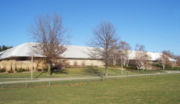
The MSU men's ice hockey team started in 1924, though it has only been a varsity sport since 1950. The team has since won national titles in 1966, 1986, and 2007. The Spartans came close to repeating the national title in 1987, but lost the championship game to the University of North Dakota. They play at MSU's Munn Ice Arena. Former head coach Ron Mason, is college hockey's winningest coach with 924 wins total and 635 at MSU. The current head coach is Rick Comley, who has a 34–19–3 record at MSU. Since the Big Ten Conference does not include Division I men's ice hockey, Michigan State competes in the Central Collegiate Hockey Association. Michigan State leads the CCHA in all-time wins, is second in CCHA Conference championships with 7 (University of Michigan has 8), and is first in CCHA Tournament Championships with 11. Along with the University of Michigan (U-M) and the Ohio State University, it is one of three Big Ten schools in the CCHA. As with other sports, the hockey rivalry between MSU and U-M is a fierce one, and on October 6, 2001, MSU faced U-M in the Cold War, during which a world record crowd of 74,554 packed Spartan Stadium to watch the game end in a 3–3 tie. In the 2006–2007 season, the Men's Ice Hockey team defeated Boston College for its third NCAA hockey championship.
Student life
East Lansing is very much a college town, with 60.2% of the population between the ages of 15 and 24. President John A. Hannah's push to expand in the 1950s and 1960s resulted in the largest residence hall system in the United States. Around 16,000 students live in MSU's 23 undergraduate halls, one graduate hall, and three apartment villages. Each residence hall has its own hall government, with representatives in the Residence Halls Association. Yet despite the size and extent of on-campus housing, the residence halls could not house anywhere near the entire undergraduate student population and 58% of students live off-campus, mostly in the " student ghettos" of East Lansing or in a co-op. One of these student-dominated neighborhoods is "Cedar Village". This is where the newly revived 70's tradition Cedar Fest takes place on the first Saturday of April. The city since has declared Cedar Village " blighted", and proposed to redevelop the 35 acre (140,000 m²) site as a complex of upscale condominiums and retail stores called East Village. Several fraternities in the affected area mounted a campaign against the redevelopment plan. The potential increase in housing expenses that would result from this proposed project has created significant resistance from students.
Greek life
With over 3,000 members, Michigan State University's Greek system is one of the largest in the nation. Started in 1872 and re-established in 1922 by Lambda Chi Alpha Fraternity, Alpha Gamma Rho Fraternity, and Alpha Phi Sorority; the MSU Greek system now consists of 55 Greek lettered student societies. These chapters are in turn under the jurisdiction of one of MSU's four Greek governing councils. Of these four, the Interfraternity Council and the Women's Panhellenic Council are each entirely responsible for their own budgets, giving them the freedom to hold large fundraising and recruitment events. MSU's fraternities and sororities hold many philanthropy events and community fundraisers. For example, in March 2008 the Greek system held Greek Week to raise $208,000 for the American Cancer Society, and $5,000 for each of these charities: Make-a-Wish Foundation (MSU Chapter), Share Laura's Hope, The Mary Beth Knox Scholarship, and the Special Olympics.
Student organizations
The Associated Students of Michigan State University (ASMSU) is the undergraduate student government of Michigan State University. It is unusual amongst university student governments for its decentralized bicameral structure, and the relatively non-existent influence of the Greek system. ASMSU representatives are nonpartisan and many are elected in noncompetitive races.
Students pay $16.75 per semester to fund the functions of the ASMSU, including stipends for the organization's officers and activities throughout the year. Some students have criticized ASMSU for not having enough electoral participation to gain a student mandate. Turnout since 2001 has hovered between 3 and 17 percent, with the most 2006 election bringing out 8% of the undergraduate student body.
Student-run organizations beyond student government also have a large impact on the East Lansing/Michigan State University community. One example is the Tower Guard honour society. Tower Guard is the oldest and one of the most respected student organizations on campus.
The Eli Broad College of Business includes 27 students organizations. The three largest organizations are the Finance Association (FA), the Accounting Student Association (ASA), and the Supply Chain Management Association (SCMA). The SCMA is the host of the university's largest major specific career fair. The fair attracts Over 100 companies and over 400 students each year.
Activism
Activists have played an important role in MSU history. During the height of the Vietnam War, student protests helped create co-ed residence halls, and blocked the routing of Interstate 496 through campus. In the 1980s, Michigan State students convinced the University to divest the stocks of companies doing business in apartheid South Africa from its endowment portfolio, such as Coca-Cola. MSU has many student groups focused on political change. Graduate campus groups include the Graduate Employees Union and the Council of Graduate Students. Michigan State also has a variety of partisan groups ranging from liberal to conservative, including the College Republicans, the College Democrats and several third party organizations. Other partisan activist groups include Young Americans for Freedom on the right; Young Democratic Socialists, Students for Economic Justice, Young Communist League and MEChA on the left. Given MSU's proximity to the Michigan state capital of Lansing, many politically-inclined Spartans intern for state representatives.
People
The current president of the University is Lou Anna Simon who took over on January 1, 2005 after being appointed by MSU's governing board, the Board of Trustees. The Board receives its mandate from the Michigan Constitution since MSU is a state-owned school. The constitution allows for eight trustees who are elected by statewide referendum every two years. Trustees have eight-year terms, with two of the eight elected every other year. As of 2007, the Board is made up of three Republicans and five Democrats.
19th century
Important College leaders in the 1800s include John C. Holmes, who kept the Agriculture School from being a part of the University of Michigan and is widely credited with being the prime mover for the school's founding; Joseph R. Williams, the first president; Also of importance was botany professor William J. Beal, an early plant (hybrid corn) geneticist who championed the laboratory teaching method. Another distinguished faculty member of the era was the alumnus/professor Liberty Hyde Bailey. Bailey was the first to raise the study of horticulture to a science, paralleling botany, which earned him the title of "Father of American Horticulture". Other famous 19th century graduates include Ray Stannard Baker, a famed " muckraker" journalist and Pulitzer Prize winning biographer; Minakata Kumagusu, a renowned environmental scientist; and William Chandler Bagley, a pioneering education reformer.
20th and 21st centuries
Today, there are around 460,000 living MSU alumni worldwide. Famous MSU alumni include former Michigan governors James Blanchard and John Engler, Michigan U.S. Senator Debbie Stabenow,U.S. ambassador to Brazil Donna Hrinak, former Jordan Prime Minister Adnan Badran, billionaire philanthropist Eli Broad, world-renowned trial lawyer Geoffrey Feiger, Pulitzer Prize-winning novelist Richard Ford, Teamsters president James P. Hoffa, Quicken Loans founder and Cleveland Cavaliers owner Dan Gilbert, Sergeant at Arms of the U.S. House of Representatives Wilson Livingood, former Michigan U.S. Senator and Secretary of Energy Spencer Abraham, former Vice President of the Republic of Liberia Harry Moniba, and former U.S. Ambassador to Italy Peter Secchia. Alumni in Hollywood include actors James Caan, Anthony Heald, Robert Urich, and William Fawcett; comedian Dick Martin, director Sam Raimi, and screenwriter David Magee. Journalists include NBC reporter Chris Hansen, AP White House Correspondent Nedra Pickler, and NPR Washington Correspondent Don Gonyea. Novelist Michael Kimball graduated in 1990. In addition, two of the Little Rock Nine attended Michigan State, including Ernest Green, the first black student to graduate from Little Rock Central High School; and Carlotta Walls LaNier.
Spartans formerly or currently in the NBA include Earvin "Magic" Johnson, Greg Kelser, Jay Vincent, Steve Smith, Scott Skiles, Jason Richardson, Mateen Cleaves, Alan Anderson, Zach Randolph, Morris Peterson and Charlie Bell. On the American Football League's All-Time Team are tight-end Fred Arbanas and safety George Saimes. In the National Football League, MSU alumni include Morten Andersen, Plaxico Burress, Andre Rison, Derrick Mason, Muhsin Muhammad, T.J. Duckett, Flozell Adams, Julian Peterson, Charles Rogers, Jim Miller, Earl Morrall, Wayne Fontes, Bubba Smith, and Drew Stanton. Former MSU quarterback Jeff Smoker now plays in the Arena Football League. Former Michigan State players in the National Hockey League include Rod Brind'Amour, Anson Carter, Donald McSween, Adam Hall, John-Michael Liles, brothers Kelly Miller and Kip Miller, as well as their cousins, brothers Ryan Miller and Drew Miller. Former Michigan State players in Major League Baseball include Hall of Fame inductee Robin Roberts, Kirk Gibson, Steve Garvey, and Mark Mulder. Olympic gold medalists include Savatheda Fynes, and Frederick Alderman. The Spartans are also contributing athletes to Major League Soccer, as midfielder Kevin Reiman was drafted by Real Salt Lake in 2008.

